Houseplants can do more than just brighten up a room. They can also purify your air.
Many people spend hundreds on air purifiers. But did you know that certain houseplants can clean your air just as well? These plants remove toxins and improve air quality. They are natural, cost-effective, and add beauty to your home. Plus, they are easy to care for, making them perfect for any indoor space.
In this post, we will explore ten houseplants that can purify your air better than a $500 air purifier. Ready to breathe easier and enjoy the greenery? Let’s get started.

Top Air-purifying Houseplants
Looking for a natural way to purify your indoor air? Houseplants might be the solution you need. They not only beautify your space but also help remove toxins. Here are the top air-purifying houseplants that work better than a $500 air purifier.
Benefits Of Indoor Plants
Indoor plants offer many advantages beyond their aesthetic appeal. They play a crucial role in improving air quality. Here are some key benefits:
- Air Purification: Plants absorb harmful toxins such as formaldehyde, benzene, and trichloroethylene. They replace these toxins with fresh oxygen.
- Humidity Control: Through transpiration, plants release moisture into the air, which can help maintain indoor humidity levels.
- Mental Health: Studies show that being around plants can reduce stress, boost mood, and increase productivity.
- Natural Decor: Plants add a touch of nature to your home decor, making your living space more inviting.
Let’s look at a few plants that excel in these areas:
| Plant | Benefits |
|---|---|
| Spider Plant | Great at removing formaldehyde and xylene. |
| Snake Plant | Excellent at absorbing toxins and producing oxygen. |
| Peace Lily | Effective at removing mold spores and other toxins. |
Choosing The Right Plants

When selecting houseplants for air purification, consider the following tips:
- Light Conditions: Different plants require different levels of light. Choose plants that match the light conditions of your home. For instance, Snake Plants thrive in low light, while Spider Plants prefer indirect sunlight.
- Maintenance: Some plants need more care than others. If you don’t have much time for plant care, opt for low-maintenance plants like the Spider Plant or Snake Plant.
- Space: Consider the size of the plant and the space it will occupy. Larger plants like the Rubber Plant can make a statement, while smaller ones like the Peace Lily fit well on desks and shelves.
Here are some top choices based on these factors:
- Low Light: Snake Plant, ZZ Plant
- Indirect Sunlight: Spider Plant, Peace Lily
- Low Maintenance: Pothos, Aloe Vera
- High Impact: Rubber Plant, Fiddle Leaf Fig
Selecting the right plants can enhance your indoor environment significantly. Choose wisely and enjoy the fresh, clean air.
Spider Plant
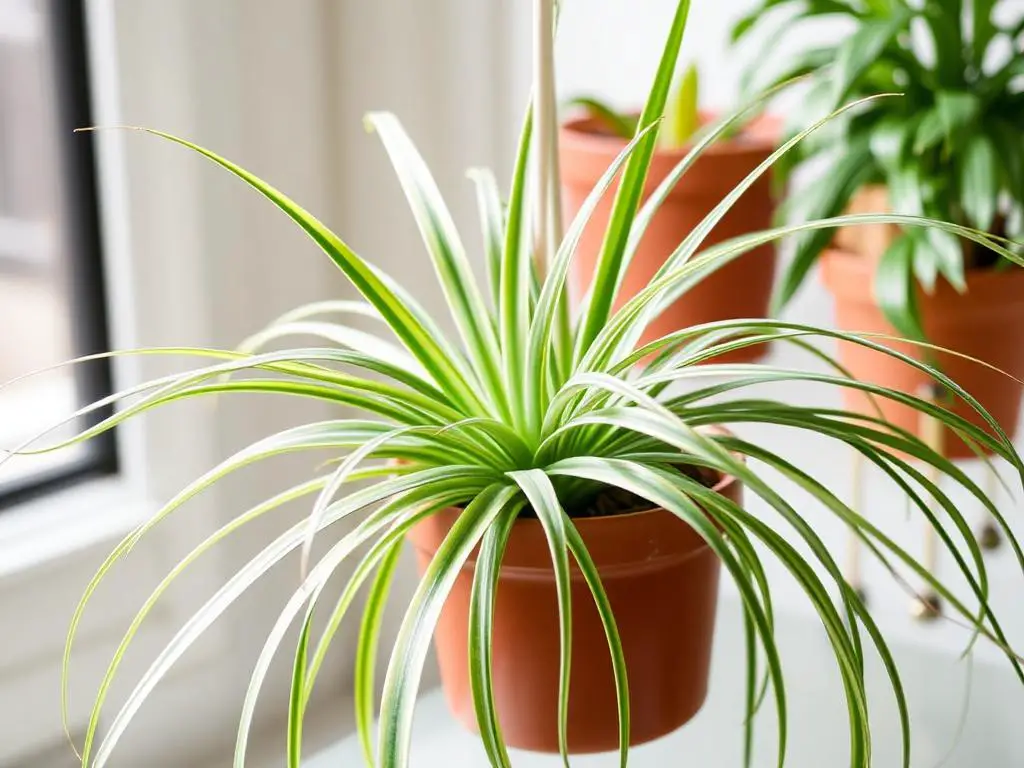
Houseplants are not only beautiful but can also purify your air better than a $500 air purifier. One of the best choices is the Spider Plant. Known for its lush green foliage and ease of care, the Spider Plant is a popular choice for many households. It doesn’t just add aesthetic value but also works hard to clean the air in your home.
Easy Care Tips
The Spider Plant is incredibly easy to care for, making it perfect for beginners or those with a busy lifestyle. Here are some simple care tips to ensure your Spider Plant thrives:
- Light: Spider Plants prefer bright, indirect sunlight. They can tolerate low light but will grow faster in brighter conditions.
- Water: Water your Spider Plant when the top inch of soil feels dry. Overwatering can lead to root rot, so ensure the pot has good drainage.
- Humidity: Spider Plants enjoy moderate humidity. If the air in your home is very dry, consider misting the leaves occasionally.
- Temperature: These plants thrive in temperatures between 60°F and 75°F (15°C and 24°C). Avoid placing them near drafts or sudden temperature changes.
- Soil: Use a well-draining potting mix. A standard houseplant soil mix works well for Spider Plants.
- Fertilizer: Feed your Spider Plant with a balanced liquid fertilizer every 2-3 months during the growing season (spring and summer).
With these easy care tips, your Spider Plant will flourish and continue to enhance your living space.
Air Quality Benefits
Spider Plants are not just easy to care for; they also offer significant air quality benefits. According to NASA’s Clean Air Study, Spider Plants effectively remove harmful toxins from the air. Here’s how they contribute to a healthier home:
- Formaldehyde Removal: Spider Plants can remove up to 90% of formaldehyde from the air. Formaldehyde is commonly found in household products like adhesives, cleaning agents, and furniture.
- Xylene and Toluene Absorption: These plants can absorb xylene and toluene, which are found in paint, nail polish, and other household chemicals.
- Carbon Monoxide Reduction: Spider Plants can help reduce levels of carbon monoxide, improving overall air quality.
- Oxygen Production: During the day, Spider Plants absorb carbon dioxide and release oxygen, which improves the air you breathe.
Incorporating a Spider Plant into your home can lead to cleaner air and a healthier living environment. By removing common indoor pollutants, Spider Plants ensure you and your family breathe easier.
| Pollutant | Removed By Spider Plant |
|---|---|
| Formaldehyde | Up to 90% |
| Xylene | Yes |
| Toluene | Yes |
| Carbon Monoxide | Reduced Levels |
By choosing the Spider Plant, you invest in a natural, effective way to purify your indoor air.
Peace Lily
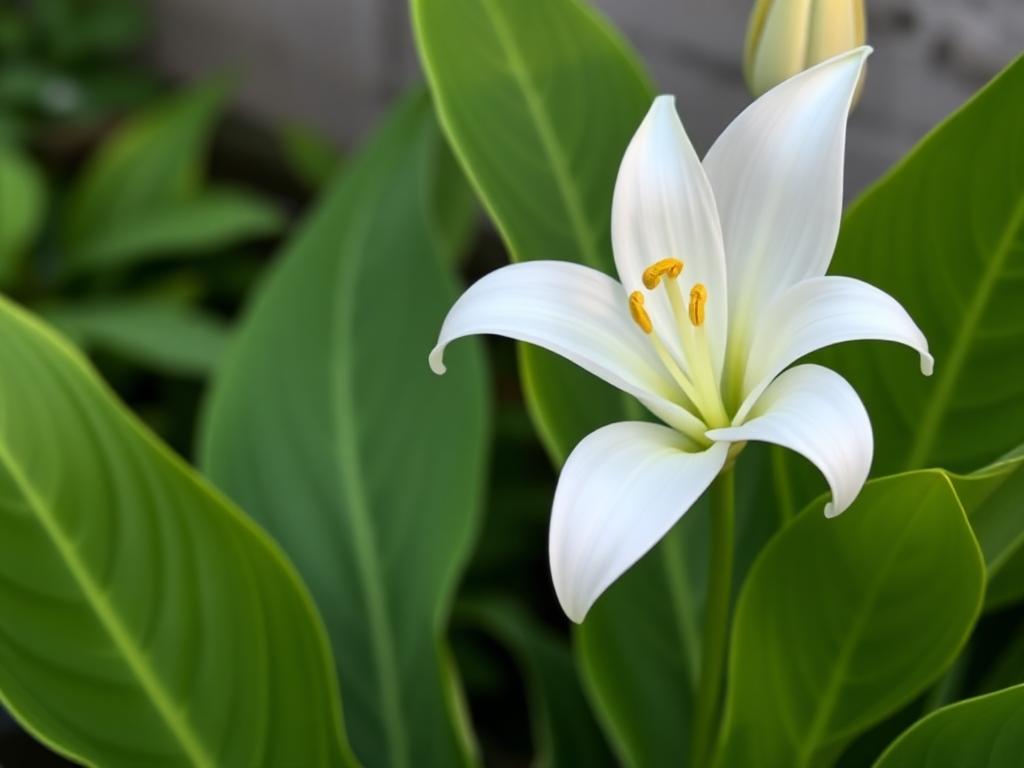
Houseplants not only add beauty to your home but also improve indoor air quality. One of the most effective plants for this purpose is the Peace Lily. This elegant plant is known for its air-purifying abilities, making it a top choice for cleaner, healthier air.
Low Light Adaptability
The Peace Lily thrives in low light conditions. This makes it a great option for rooms that don’t get much sunlight. You don’t need to place it near a window. It can grow well in corners and shaded areas.
Here are some key points about its light needs:
- Minimal sunlight: Peace Lilies can survive with minimal sunlight. They do well in artificial light too.
- Indirect light: If you place them in indirect light, they will flourish. Direct sunlight can scorch their leaves.
- Adaptable: They adapt easily to different lighting conditions. This makes them a versatile choice for any room.
Below is a table that summarizes the light requirements:
| Light Condition | Peace Lily Response |
|---|---|
| Low Light | Thrives |
| Indirect Light | Flourishes |
| Direct Sunlight | Scorches |
Peace Lilies are perfect for homes and offices. You don’t need to worry about keeping them in bright spaces. Their ability to adapt to low light makes them a low-maintenance plant.
Toxin Removal Properties
The Peace Lily is excellent at removing toxins from the air. Its leaves absorb harmful substances and break them down. This improves the air quality significantly.
Here are some toxins that the Peace Lily can remove:
- Benzene: Commonly found in paints, detergents, and plastics.
- Formaldehyde: Present in furniture, carpets, and household products.
- Trichloroethylene: Found in adhesives, paint removers, and cleaners.
- Xylene: Present in rubber, leather, and printing industries.
- Ammonia: Found in cleaning products and fertilizers.
Here is a table showing the toxins and their sources:
| Toxin | Source |
|---|---|
| Benzene | Paints, Detergents, Plastics |
| Formaldehyde | Furniture, Carpets, Household Products |
| Trichloroethylene | Adhesives, Paint Removers, Cleaners |
| Xylene | Rubber, Leather, Printing Industries |
| Ammonia | Cleaning Products, Fertilizers |
Peace Lilies help reduce the levels of these toxins in your home. This makes your indoor air healthier and fresher. They are one of the best plants for purifying the air.
Snake Plant
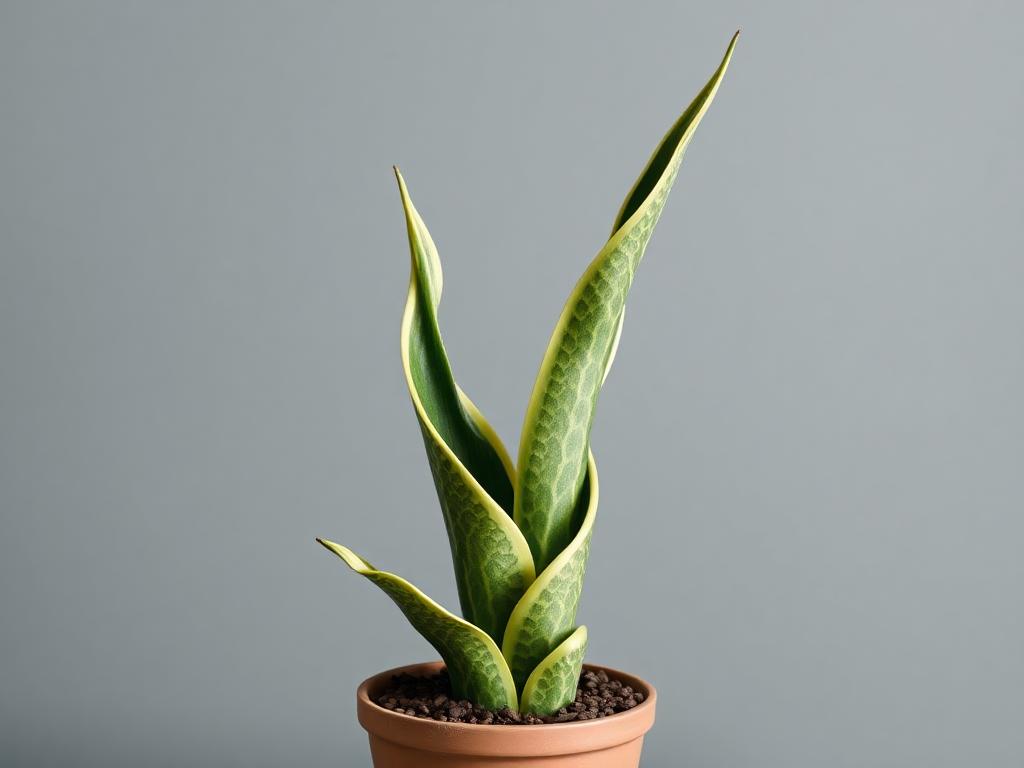
Want cleaner air at home? Consider houseplants. They not only look beautiful but also purify the air. One of the best is the Snake Plant. Known for its striking leaves, this plant can actually improve air quality better than some expensive air purifiers. Let’s dive into how it works.
Oxygen Production
The Snake Plant is exceptional at producing oxygen. Unlike many plants, it produces oxygen even at night. This makes it perfect for bedrooms. Here’s why:
- Photosynthesis: It converts carbon dioxide into oxygen during the day.
- Crassulacean Acid Metabolism (CAM): It continues to convert CO2 to oxygen at night.
For those interested in numbers, check out the table below:
| Time | Oxygen Production |
|---|---|
| Day | High |
| Night | Moderate |
This dual action not only keeps your air fresh during the day but also boosts oxygen levels at night. No need for a $500 air purifier. The Snake Plant does the job at a fraction of the cost. Just place it in your room and breathe easy.
Nighttime Air Purification
Most plants need sunlight to perform photosynthesis. The Snake Plant is different. It purifies the air even in the dark. This makes it unique among houseplants. Here’s how it helps:
- Absorbs Toxins: It removes harmful toxins like formaldehyde and benzene from the air.
- Releases Oxygen: It releases oxygen during the night, unlike many plants that only do so during the day.
Imagine sleeping in a room where the air is constantly being purified. Studies have shown that better air quality leads to better sleep. Here’s a quick comparison:
| Air Quality | Sleep Quality |
|---|---|
| Poor | Interrupted |
| Good | Restful |
So, if you want to improve your sleep and breathe cleaner air, add a Snake Plant to your room. It’s an easy, natural solution that works 24/7.
Boston Fern
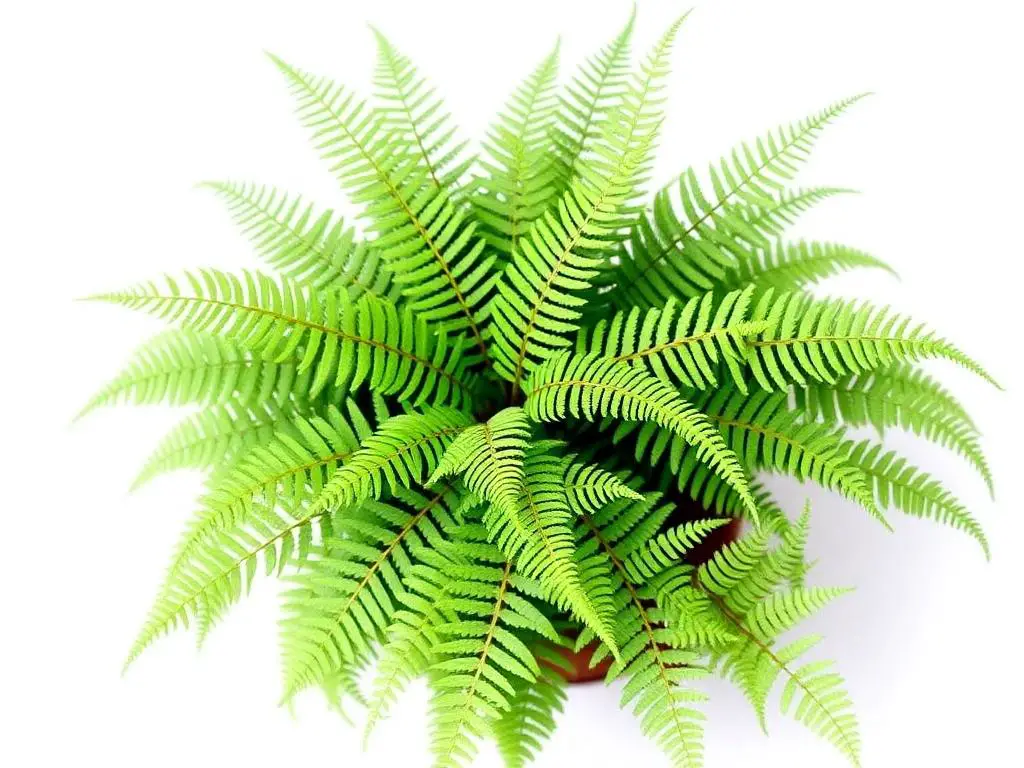
Houseplants are a great way to improve indoor air quality. Some plants are so efficient, they outperform expensive air purifiers. One standout is the Boston Fern. This lush, green plant not only looks beautiful but also cleans the air. It’s especially effective at removing formaldehyde and other toxins. Let’s dive into why the Boston Fern is such a valuable addition to your home.
Humidity Regulation
The Boston Fern excels at regulating indoor humidity levels. This plant naturally increases humidity by releasing moisture into the air through a process called transpiration. The benefits of having a Boston Fern in your home include:
- Reduced Dryness: Keeps the air moist, reducing skin irritation and respiratory issues.
- Improved Comfort: Ideal for homes with dry air due to heating systems.
- Healthier Environment: Helps maintain healthy humidity levels between 30-50%.
To maximize its humidity-regulating properties, place your Boston Fern in rooms where dry air is most problematic. Common areas include:
| Room | Benefit |
|---|---|
| Living Room | Reduces static electricity and keeps skin hydrated. |
| Bedroom | Promotes better sleep by keeping the air moist. |
| Office | Improves focus and reduces eye strain. |
Maintenance Requirements
The Boston Fern is relatively low-maintenance, making it an excellent choice for busy individuals. Here are the key care tips:
- Lighting: Prefers indirect sunlight. Avoid direct sun which can scorch the leaves.
- Watering: Keep the soil consistently moist. Water when the top inch of soil feels dry.
- Humidity: Thrives in high humidity. Mist regularly or use a humidity tray.
- Temperature: Ideal range is 60-75°F (15-24°C). Avoid cold drafts and sudden temperature changes.
Here’s a quick reference table for the Boston Fern’s care needs:
| Requirement | Details |
|---|---|
| Light | Indirect sunlight |
| Water | Consistently moist soil |
| Humidity | High, regular misting |
| Temperature | 60-75°F (15-24°C) |
With these simple care steps, your Boston Fern will thrive and continue to purify your air effectively. Its low-maintenance nature makes it a perfect addition to any home.
Aloe Vera
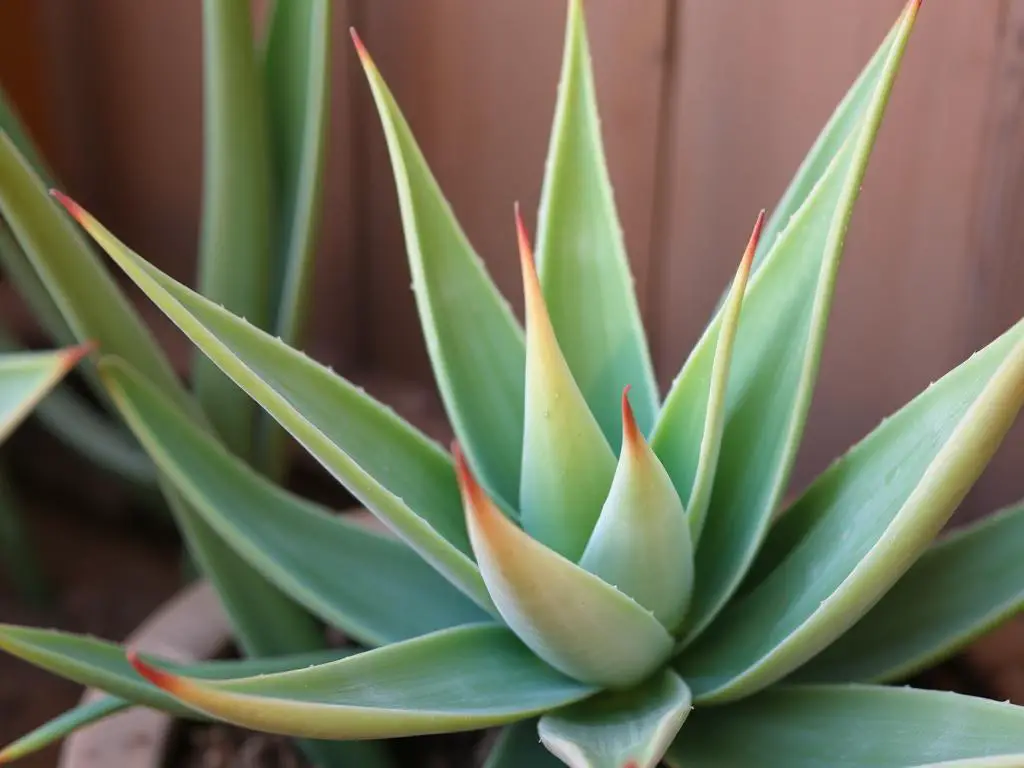
Are you tired of spending hundreds of dollars on air purifiers? Did you know that some houseplants can do the job just as well? One such plant is Aloe Vera. This amazing plant does more than just purify the air. It also has incredible healing properties. Let’s dive into the benefits of having Aloe Vera in your home.
Healing Properties
Aloe Vera is famous for its healing properties. This plant has been used for centuries to treat various skin conditions. Here are some of the healing benefits:
- Soothes burns and cuts: Aloe Vera gel is known for its cooling and soothing effects on minor burns and cuts.
- Moisturizes skin: The gel from the Aloe Vera plant keeps your skin hydrated and smooth.
- Reduces inflammation: It can help reduce skin inflammation, redness, and itching.
- Heals wounds: Aloe Vera accelerates the healing process of wounds and reduces scarring.
These healing properties make Aloe Vera a must-have plant in your home. It can be used in its natural form or as part of various skincare products. The gel is easy to extract. Simply cut a leaf, and squeeze the gel out. You can apply it directly to your skin.
Aloe Vera is also known to improve digestion. Consuming Aloe Vera juice can help with digestive issues. It is rich in vitamins and minerals, which boost your immune system.
Air Filter Capabilities
Aloe Vera not only heals your skin but also purifies the air. This plant is a natural air purifier. Here are some of its air-filtering capabilities:
- Removes toxins: Aloe Vera absorbs harmful toxins like formaldehyde and benzene from the air.
- Improves air quality: By removing pollutants, it enhances the air quality in your home.
- Releases oxygen: Aloe Vera releases oxygen at night, which can improve your sleep quality.
According to NASA’s Clean Air Study, Aloe Vera is one of the best plants for air purification. It can absorb up to 90% of harmful chemicals. The plant is efficient in small spaces. Place it in your bedroom or living room for the best results.
Here is a table summarizing the benefits of Aloe Vera:
| Benefit | Description |
|---|---|
| Soothes Burns | Cooling and soothing effects on minor burns. |
| Moisturizes Skin | Keeps skin hydrated and smooth. |
| Reduces Inflammation | Reduces redness, itching, and inflammation. |
| Heals Wounds | Accelerates healing and reduces scarring. |
| Removes Toxins | Absorbs harmful toxins like formaldehyde and benzene. |
| Releases Oxygen | Releases oxygen at night, improving sleep quality. |
Aloe Vera is easy to care for. It needs minimal watering and thrives in indirect sunlight. This makes it an ideal plant for busy households. Adding Aloe Vera to your home can improve both your health and your air quality.
Rubber Plant
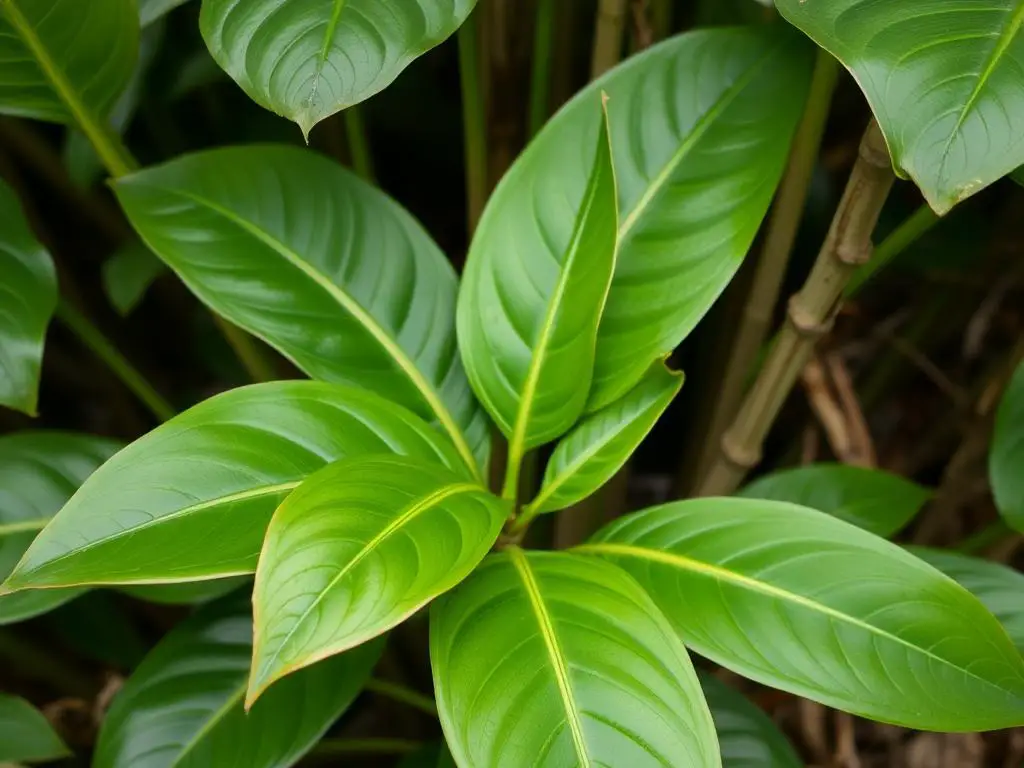
Houseplants can do wonders for your indoor environment. Not only do they add a touch of nature to your home, but many also have the ability to purify the air. Among these, the Rubber Plant stands out. It’s not just a pretty face; it’s a powerful air purifier that can outperform even a $500 air purifier in some aspects.
Growth Conditions
The Rubber Plant, or Ficus elastica, is relatively easy to care for. Its adaptability makes it a favorite among both novice and experienced plant enthusiasts. Here are the ideal growth conditions for a Rubber Plant:
- Light: Prefers bright, indirect light but can tolerate low light.
- Temperature: Thrives in temperatures between 60°F and 75°F.
- Watering: Water when the top inch of soil is dry. Avoid overwatering.
- Humidity: Prefers moderate humidity. Misting can help during dry seasons.
- Soil: Well-draining potting soil is essential.
To further enhance its growth, you can use a balanced liquid fertilizer once a month during the growing season. Here’s a quick reference table for Rubber Plant care:
| Aspect | Ideal Condition |
|---|---|
| Light | Bright, indirect |
| Temperature | 60°F – 75°F |
| Watering | When top inch of soil is dry |
| Humidity | Moderate |
| Soil | Well-draining |
Allergen Reduction
The Rubber Plant is not just a visual delight; it also contributes to a healthier living space. It has a unique ability to reduce allergens in the air, making it perfect for allergy sufferers. Here’s how it helps:
- Absorbs Pollutants: The Rubber Plant can absorb airborne chemicals like formaldehyde, benzene, and trichloroethylene.
- Releases Oxygen: It releases oxygen, which can improve air quality and make it easier to breathe.
- Dust Reduction: The large leaves of the Rubber Plant can trap dust particles, reducing the amount of dust in your home.
For optimal allergen reduction, keep the leaves clean by wiping them with a damp cloth weekly. This helps the plant to better absorb pollutants and perform photosynthesis more efficiently.
In summary, the Rubber Plant is a powerful ally in maintaining a clean and healthy indoor environment. Its ability to purify the air and reduce allergens makes it a valuable addition to any home.
Dracaena
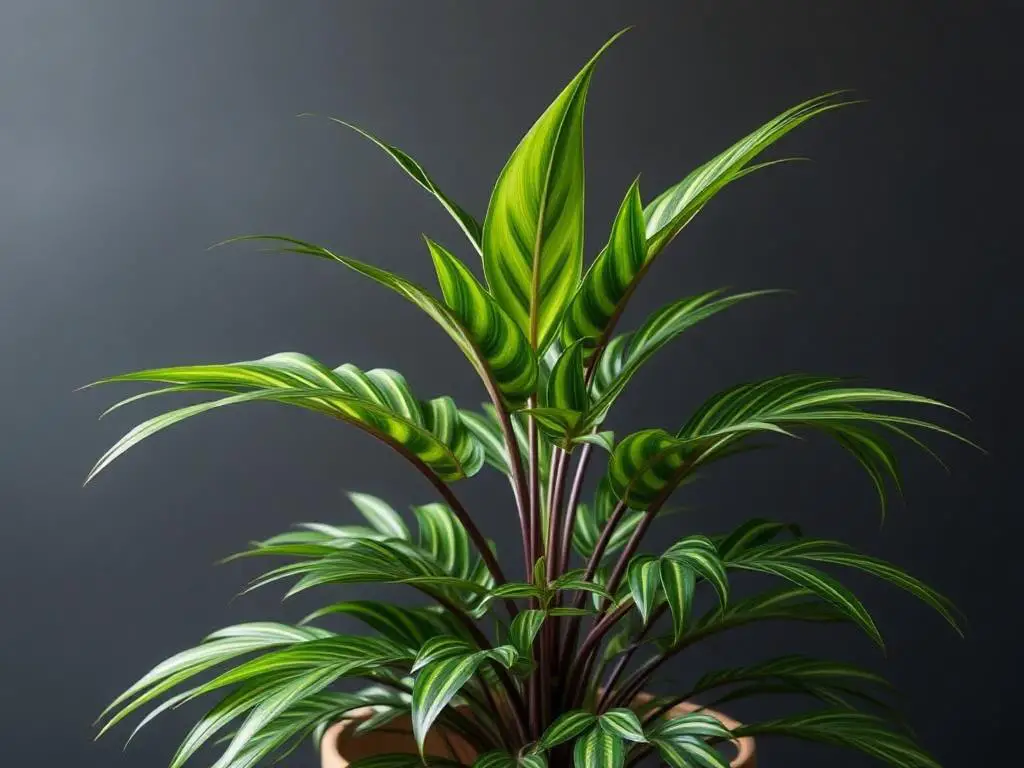
When it comes to purifying indoor air, houseplants can be more effective than expensive air purifiers. One standout plant in this regard is the Dracaena. Not only is it visually appealing, but it also has impressive air-cleaning abilities. Dracaena plants are easy to care for and come in various types, each with unique features.
Varieties And Selection
There are over 40 different species of Dracaena, making it easy to find one that suits your home. Some popular varieties include:
- Dracaena Marginata: Known for its long, thin leaves with red edges. It is also called the Madagascar Dragon Tree.
- Dracaena Fragrans: Also known as Corn Plant, it has wide, green leaves and can grow quite tall.
- Dracaena Reflexa: Often called Song of India, it features green leaves with yellow or cream edges.
- Dracaena Deremensis: Includes varieties like Janet Craig and Warneckii, known for their striped foliage.
When selecting a Dracaena, consider the lighting in your home. While some varieties can tolerate low light, most prefer bright, indirect sunlight. Here’s a quick comparison:
| Variety | Light Requirements | Height |
|---|---|---|
| Dracaena Marginata | Bright, indirect light | Up to 15 feet |
| Dracaena Fragrans | Low to bright, indirect light | Up to 10 feet |
| Dracaena Reflexa | Bright, indirect light | Up to 6 feet |
| Dracaena Deremensis | Low to bright, indirect light | Up to 5 feet |
Chemical Absorption
Dracaena plants are not just beautiful; they are also effective at absorbing harmful chemicals from the air. According to NASA’s Clean Air Study, Dracaenas can remove several toxins, including:
- Formaldehyde: Found in household products like paper towels and tissues.
- Benzene: Present in paints, detergents, and furniture wax.
- Trichloroethylene: Commonly found in adhesives and paint removers.
- Xylene: Found in solvents and thinners.
These chemicals can cause various health problems, such as headaches, dizziness, and respiratory issues. Dracaena plants absorb these toxins through their leaves and roots, making your indoor air cleaner and healthier.
Here’s how it works:
- Dracaena leaves take in air through small openings called stomata.
- The plant’s roots and microbes break down harmful chemicals into less toxic substances.
- Clean air is released back into your home.
For optimal chemical absorption, keep your Dracaena in well-draining soil and water it regularly. Avoid overwatering, as this can lead to root rot. With proper care, Dracaena plants can thrive and provide continuous air purification.
Pothos
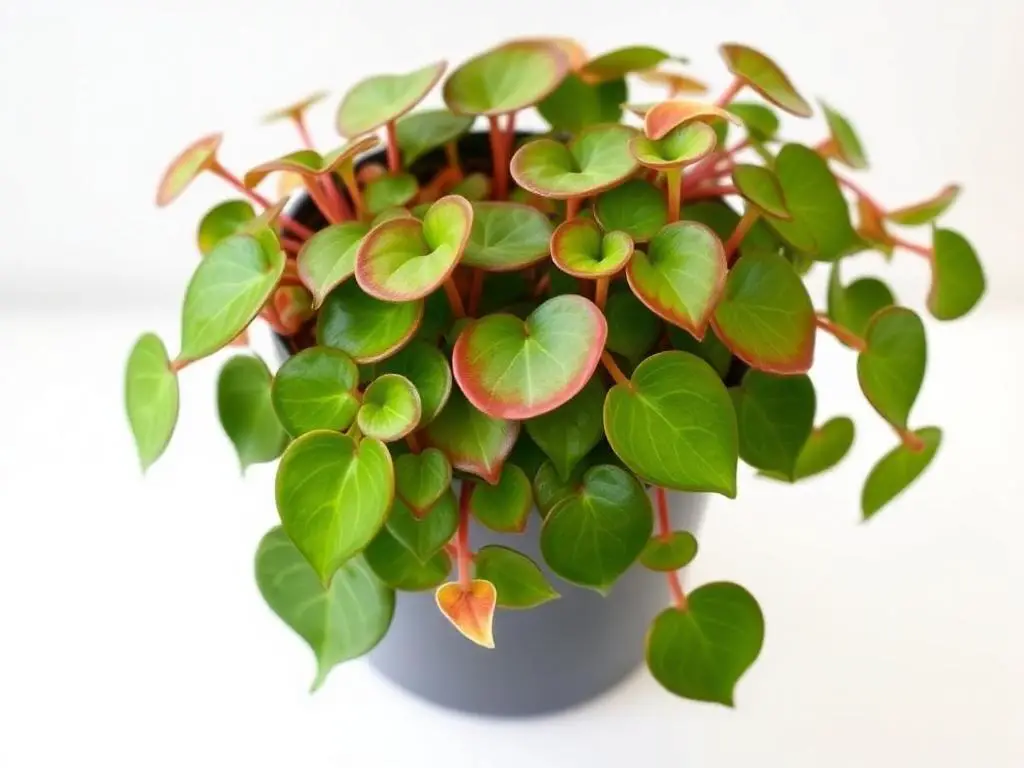
Houseplants not only add beauty to your home but can also purify your air. Some plants are so effective that they outperform expensive air purifiers. One such plant is the Pothos. This easy-to-care-for plant is perfect for beginners and experts alike.
Fast Growth Rate
Pothos are known for their fast growth rate. Within a few weeks, you can see new leaves and vines sprouting. This rapid growth helps purify the air quicker than many other plants.
Here are some benefits of its fast growth rate:
- More leaves mean more air purification.
- Quickly fills empty spaces with greenery.
- Easy to propagate and share with friends.
To encourage faster growth, keep these tips in mind:
- Light: Pothos thrive in low to bright indirect light.
- Water: Water when the top inch of soil is dry.
- Soil: Use well-draining potting mix.
Comparing Pothos to other houseplants:
| Plant | Growth Rate |
|---|---|
| Pothos | Fast |
| Snake Plant | Slow |
| Spider Plant | Moderate |
Versatile Placement
Pothos are incredibly versatile when it comes to placement in your home. They adapt to various light conditions, from low light to bright, indirect light. This makes them suitable for almost any room.
Here are some ideas for placing your Pothos:
- Living Room: Place on a shelf or let it trail from a hanging basket.
- Bedroom: Keep on a nightstand to improve air quality while you sleep.
- Bathroom: Pothos thrive in humid environments.
- Kitchen: Brighten up your cooking space with some greenery.
Key advantages of Pothos placement:
- Can grow in water or soil.
- Perfect for hanging baskets or climbing structures.
- Survives in low-light areas where other plants struggle.
Whether you are looking to add some greenery to your living room or purify the air in your bedroom, Pothos is a versatile and effective choice.
Zz Plant
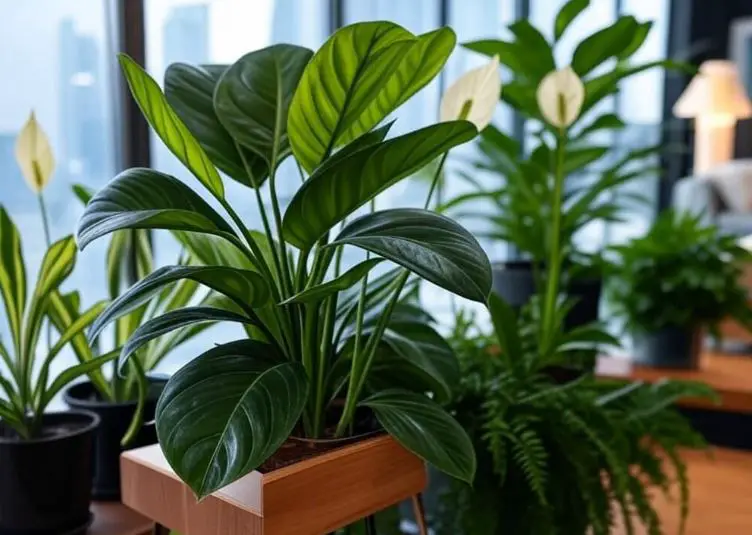
Houseplants not only add a touch of nature to your home but also work as natural air purifiers. One of the most effective plants in this category is the ZZ Plant. Known for its beautiful, waxy leaves and sturdy nature, the ZZ Plant is a favorite among plant enthusiasts. It can thrive in various conditions and is known for its air-purifying abilities.
Low Light Tolerance
The ZZ Plant is famous for its low light tolerance. This makes it perfect for indoor settings, even in rooms with minimal natural light. Here are some key points about its adaptability:
- The ZZ Plant can survive in dimly lit spaces.
- It requires little direct sunlight, making it ideal for offices and apartments.
- Even under fluorescent lighting, it continues to grow well.
Its ability to thrive in such conditions means you won’t need to worry about placing it near windows. Just water it occasionally, and it will stay healthy and vibrant. This ease of care makes it a perfect choice for beginners or those with a busy lifestyle.
Air Purifying Strength
Beyond its resilience, the ZZ Plant is powerful in purifying the air. It can remove toxins and improve indoor air quality. Here’s how it excels:
- Effectively filters out xylene, toluene, and benzene.
- Absorbs carbon dioxide and releases oxygen, enhancing air freshness.
- Contributes to reducing indoor air pollution levels.
Studies have shown that the ZZ Plant can significantly improve air quality. It reduces harmful chemicals commonly found in household products. This makes it a healthy addition to any home or office. The plant’s air-purifying qualities are comparable to those of high-end air purifiers but without the hefty price tag.
Overall, the ZZ Plant stands out not only for its beauty but also for its functional benefits. Its low maintenance and air-purifying capabilities make it a must-have for anyone looking to improve their indoor environment.
Conclusion
Breathing clean air at home is important. Houseplants offer a natural solution. They look beautiful and improve air quality. Affordable and easy to maintain. Unlike expensive purifiers, these plants fit any budget. Enjoy fresher air and a greener home. Your health and wallet will thank you.
Start with just one plant today. Notice the difference in your living space. Your journey to better air quality can begin now. Happy planting!
